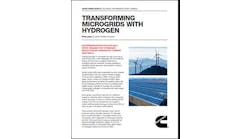Ireland based initiative, Innovation Green, has set out to develop a 100% renewable microgrid to power a trade and distribution campus in the center of the island.
Located in the Midlands Region, a central area of Ireland, Innovation Green is a co-operation between Midlands Airport Developments, InSite Bavaria, the Technical University of Munich, Siemens and Amova. The renewable energy campus aims to create growth and provide green energy jobs in the region.
The campus will provide a center of excellence for companies and researchers to develop and test renewable and sustainable energy solutions. These solutions could be scalable and repeatable for international replication.
No legacy systems
Siemens Ireland, the technical partner on the project, is interested in the greenfield nature of the site.
“It’s an empty sandbox, you can basically build whatever you want, you’ve no legacy systems or no legacy infrastructure that you need to worry about,” Gary O’Callaghan, CEO Siemens Ireland, told Microgrid Knowledge.
Early feasibility work has estimated a peak energy demand of 300 MW for the site, to be supplied by the microgrid. A combination of wind, solar, waste to energy, and anaerobic digestion will meet the demand. There are also plans to use batteries and hydrogen, produced from the wind farm’s off-peak electricity, for energy storage.
“If the batteries were low and the wind wasn’t blowing, they would then use hydrogen to generate electricity through a gas generator,” O’Callaghan explained.
Bringing technology together
An electric vehicle network and a microgrid controller, gathering data about the buildings and the energy system, will form part of the scheme.
Innovation Green may be an opportunity for Siemens Ireland to bring their smart buildings and smart grid solutions together.
“Practically every piece of technology we have in our smart infrastructure company is in scope here,” O’Callaghan said.
The next steps will be to carry out detailed design to verify the profile of the energy demand, and design the supply side.
Track news about renewable microgrid projects. Subscribe to the free Microgrid Knowledge newsletter.







